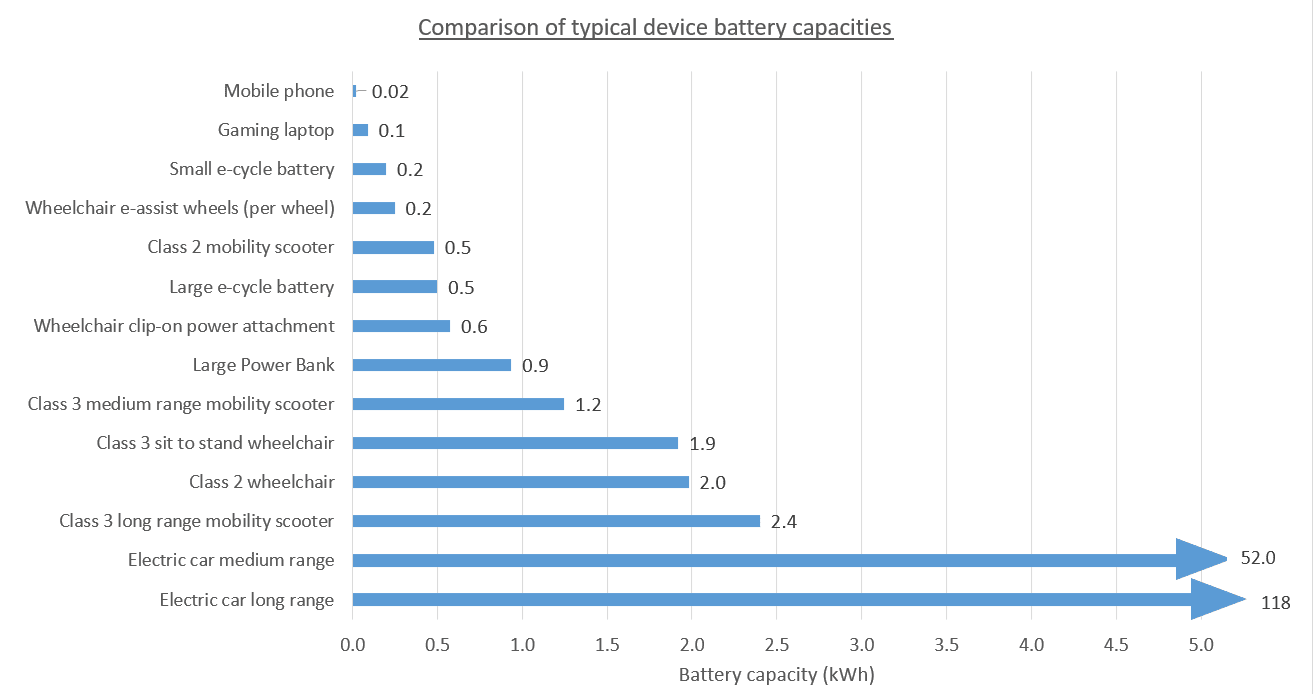Download this position statement in Word format
Download this position statement in pdf format
You may also be interested in our guide sheet on choosing e-assist cycles
Introduction
New statutory guidelines on lithium-ion battery safety for e-bikes were released by the government’s Department for Business and Trade’s Office for Product Safety and Standards on 12th December 2024.
Wheels for Wellbeing broadly support the introduction of statutory guidance to improve the safety of lithium-ion powered devices:
We would like to highlight that Disabled people are at greater risk of injury or death in building fires due to being less able to escape. Reduction of fire risk is clearly important for Disabled people’s safety and equality.
Disabled people also need safe, affordable mobility options which provide sufficient mobility range to make essential journeys. This must include e-powered and e-assist devices including wheelchairs, mobility scooters, micro-mobility and e-cycles: E-cycles are essential mobility aids for many Disabled people.
In line with the above, we have two key concerns about the current statutory guidelines:
Our concerns
- The statutory guidelines cover only batteries intended for use on “e-bikes”, not comparable capacity batteries intended for use in other devices. As such, these statutory guidelines are not comprehensive enough to reduce Li-ion battery fire risk from either batteries used in illegal or modified e-cycles and motorcycles, or from Li-ion batteries used in other devices, including mobility devices, and charged in homes and workplaces.
- The specific targeting of “e-bikes” in these guidelines perpetuates the harmful myth that legal EAPCs pose a high fire risk. This myth is being used to justify restrictions on EAPC use by housing providers, service providers, workplaces and transport providers, fueling public fear of e-cycles, including amongst Disabled people. One consequence will be reduction in e-cycle availability and e-cycle maintenance options, harming the mobility options of Disabled people, many of whom can or could use EAPCs as mobility aids to make essential journeys. Reduced active mobility decreases Disabled people’s ability to take part in daily life, including employment, education, healthcare, self-care and care of others, community activities and leisure, also harming the government’s growth, health and green missions.
We ask that:
- The statutory guidelines are updated to cover lithium ion batteries intended for any use which are likely to be stored or charged in homes and which are of a capacity sufficient to present a significant risk in case of thermal runaway.
- The statutory guidelines are altered to clarify the very low fire risk posed by legal, unmodified EAPCs.
Reducing fire risk by regulating safety for all Li-ion batteries:
We fear that the current statutory guidelines on Li-ion safety will fail to sufficiently reduce Li-ion related fires, injuries and deaths, because:
- Batteries intended for use in devices legal for use on private land and which are very similar in use, function and battery capacities to e-cycles, such as e-scooters and other micro-mobility devices, are presently not included in these Li-ion battery safety statutory guidelines.
- Batteries intended for use in devices which use similar batteries to e-cycles, from power banks to laptops to power tools, are currently not included in these Li-ion battery safety statutory guidelines:
Battery size comparison:

- Devices intended for use by Disabled people, including powerchairs and mobility scooters, innovative powered mobility aids and their supplied batteries, are already regulated for safety as Class 1 Medical Devices via the MHRA – see our guide sheet on mobility aids for more information. However, batteries purchased separately for these devices, especially from unregulated online sources, could potentially also present an increased fire hazard compared to properly safety regulated batteries.
The limited range of the current statutory guidance means that batteries of the same size and same potential risk as “e-bike batteries” can be sold for use in devices not covered by statutory guidelines without safety measures the guidelines require. The batteries will then either directly create a fire risk in their intended use, or could be modified for use in e-cycles and illegal e-motorcycles, and pose an even larger fire risk that way.
Unscrupulous individuals or organisations can easily avoid the requirements of the current statutory guidelines by simply claiming (truthfully or otherwise) that their batteries are intended for use in devices other than e-cycles, and so continue selling dangerous, unregulated, high-fire-risk batteries in the UK.
Without including all lithium-ion batteries above a given capacity within a single regulatory framework, we believe these statutory guidelines cannot be effective.
Minimising negative impact of the statutory guidance on Disabled people’s mobility:
Legal EAPCs are essential mobility aids for many Disabled people. With wider public acceptance and consistently facilitated use in private as well as public spaces, they could be valuable mobility aids to many more.
We are seeing bans and threats of bans for legal, reputable EAPCs from work premises, services, housing and public transport. These bans and the threat of further restrictions are preventing Disabled people from using the mobility aids that work for us to make essential journeys. The government’s own guidance on e-cycle and e-scooter fires states that the fire risk from “e-bikes” is very largely caused by modified e-bikes, illegal e-scooters and illegal e-motorcycles, often being charged with incompatible chargers, or with damaged batteries.
Comparison of relative risk of e-mobility fires vs other causes of fires:
- In 2023, there were 338 attended e-mobility fires compared to an overall figure of 178,737 attended fires April 2022 to March 2023: E-cycle and e-scooter fires make up under 0.2% of all attended fires.
- The biggest five causes of fatal building fires are smokers’ materials, cooking appliances, electrical distribution, candles and space heating: E-cycles and e-mobility more broadly are not measured as a separate category but potentially fit into the sixth listed cause of fatal fires “other electrical appliances”. (Home Office detailed analysis of fires 2022-23 figure 5.1)
- There were 18,665 attended road vehicle fires in 2023-24 – motor vehicles caused 5500% more attended fires than e-cycles and micro-mobility caused in the closest comparable period.
